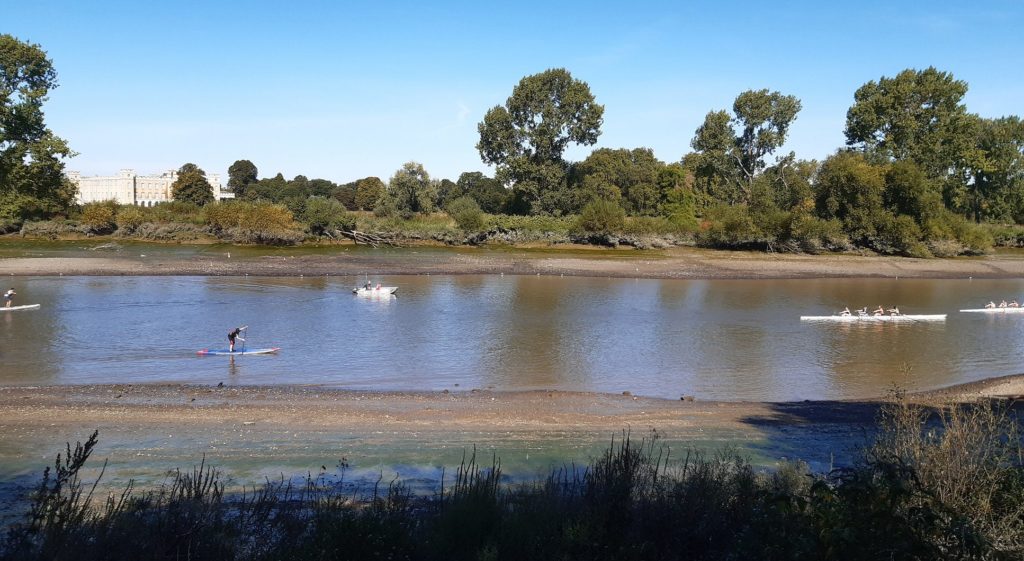
London’s Wild Riverside


In an earlier post, Archaeology: Human Natural History, I wrote about some of the wonderfully rich history that can be gleaned from a walk along the bed of the River Thames at low tide. I delighted in the pottery and pipe-bowls, as I do still.
But today, on a gloriously sunny, still and almost warm day with the tide right out, and the Egyptian Geese honking stridently and flying about — three pairs, and an equally loud loner — my walk along the river produced unexpected and equally delightful results.
Along with a nice potshard of Maling ware (it says “S” “MAL” and half an “H”) , I found an enormous toe-bone of a horse, 95 mm long. It fits snugly in my hand; it’s roughly the size and shape of a pistol grip, and as heavy. It was a proximal phalanx – the sequence is distal (hoof bone) – medial – proximal as you go up the leg. Now, today, one can barely imagine throwing a horse bone into a river. But in the days before public health officers and EU safety regulations, it was nothing strange. For a start, London was full of horses, both fine beasts for gentlemen to ride, or to pull their carriages; and small, tired, sometimes broken-down nags that pulled the rag-and-bone man’s recycling cart, and everything in between. For another thing, people ate horsemeat, as they do today (in decreasing amounts) all across the continent of Europe. If you were poor in Victorian London, horse stew must have been a rich, warm, nutritious and welcome dish: even if the horse had died of old age.
In the soft light, a set of old wooden steps, the timbers worn and scoured by thousands of tides carrying currents of mud, sand, shell and even shingle, were quite beautiful in their natural simplicity, revealing the structure and fibres of the once-thick and rectangular treads.
On the sand a little way further were scatters of Oysters and Cockles, with some other kinds of clam for good measure.
Now at first sight there is nothing very surprising about finding shells in a tidal river: sea shells, sea water. But these are fully marine species: they need salt. And are they not suspiciously fresh? Indeed, they are still articulated. Someone, having enjoyed an excellent seafood dinner, has still, this year, happily thrown out their shells onto the river bed, just as their ancestors did before them through the centuries. The fresh pottery fragments indicate that broken cups, plates (and indeed also pub glasses and bottles) similarly continue to find their way into the the river’s archaeology, just as they have for centuries, if not millennia. The river of life flows on; man’s natural history, his interaction with wild-caught or farmed animals (from horses to horse mussels, perhaps) leaves behind its small detritus of bone and shell, from one generation to the next.
What will the archaeologists of 2,000 years hence make of our generation, our few varves in some long sequence of layers of lake-mud? It is a curious reflection. In the sixties we hoped that it wouldn’t be a plutonium-iridium layer for them to puzzle over. Let’s again hope that it won’t be that.
One of the delights of living near the River Thames is a winter walk at low tide. The sides of the river – many feet deep at high water – are exposed as wide, gently shelving slopes of mud, sand, and grit. On closer inspection, much of the gritty material is anthropogenic. The implied natural history is full of interest.
There are mutton bones, rabbit bones, chicken or larger bird bones, probably swan or goose: these must usually be the remains of meals, or perhaps butchers’ or poulterers’ waste. Sometimes a bone is cleanly sawn or hacked across (there’s one in the picture).
Also of animal origin are the shells: the commonest are sea-shells – oysters, cockles, scallops, mussels. All of these were widely eaten and cheap throughout the Middle Ages, up to the 18th or 19th century. As the river here is not saline enough for these species, they must, like the animal bones, represent the remains of meals, most likely thrown out into the river by servants doing the washing-up.
Most of the remaining pieces are ceramic: thee are thick chunks of earthenware, from massive flowerpots to handsomely decorated glazed household pots. There are mass-produced pots such as Victorian marmalade jars of MALING ware from NEWCASTLE. There are glimpses of writing on fragments of fine bone china, some of it delicately moulded with leafy patterns. There are shards of blue-and-white Willow Pattern, in imitation of real but costly “China” from China. Thee are neat pieces of plates, cups, saucers. There are circular bases of bottles, jars or jugs. There are handles of teacups, carefully shaped to a standard pattern. And there are stems and bowls of unglazed clay (tobacco) pipes, sometimes plain, sometimes fancifully moulded, and thrown away when they broke, which was often.
On this evidence, the natural history of Man in London included eating meat and shellfish; storing assorted solids and liquids; and smoking a great deal of tobacco. Unlike all other species, however, Man shaped a great many artefacts; and wrote symbols on to them, apparently conveying meaning, such as the names of the artefacts’ makers. Man in London thus seems to have been both a typical species with a varied diet; and a unique, symbol-using one.